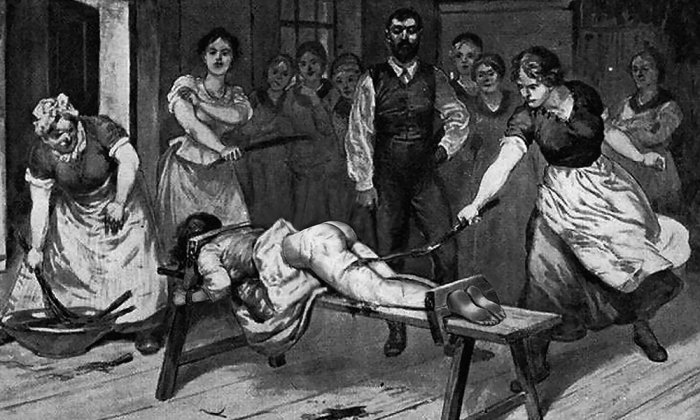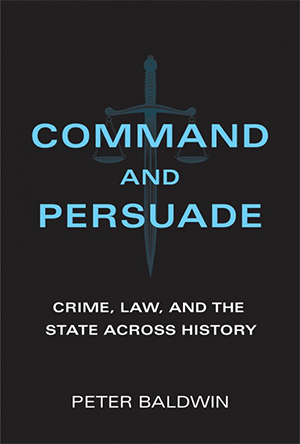Why Punish?

Many of us worry about crime, fearing that it rises inexorably and we are ever likelier to be its victims. Politicians of all stripes encourage such anxiety, promising to be tough on criminals and delivering their just punishments. But in fact, our era is the safest and least violent in human history. We are less likely to killed, assaulted, or otherwise physically harmed today than ever before.
For other kinds of offenses, such improvement is less clear. Today we have more ways of violating the law and therefore more potential crimes than earlier. We are wealthier and therefore own more things that may be stolen. New technologies bring new crimes. The most common offense is now the robocall — committed an estimated 180 million times daily in the U.S. alone. But these are not the sort of violations that keep us awake at night. How to come to grips with crime therefore preoccupies us. Threats of punishment are society’s leverage over criminals — that seems obvious. But the reasons why we punish are many and often contradictory, as you’ll see in the text that follows, and they have varied over the course of history.
Many motives have prompted crime’s punishment, and they have historically shifted in emphasis and focus. The fundamental philosophical dispute has pitted retribution and a hope of delivering justice for the wronged against a more utilitarian concern with diminishing crime that was willing to employ techniques that did not necessarily treat the harmed as they deserved. An innocent good-faith buyer of stolen property, for example, was usually considered its legal owner. The need to keep markets unencumbered by endless disputes over title took precedence over the original owner’s absolute title: Efficiency trumped fairness. These opposing positions have been argued in largely all eras. Though the two are theoretically exclusive, in fact some combination of justice and usefulness has motivated almost all state actions.

The kin groups who once settled disputes among themselves typically sought revenge and retribution. Harm needed to be set right, an out-of-kilter moral balance reequilibrated. Compensation was demanded for damage to life and limb, to intangible property (the monetary value of men’s sexual monopoly over women), or to reputation. Ancient and early medieval law listed precise values: for each particular mutilation or for the rape of other men’s wives, daughters, or female slaves. But how to deal with losses that were hard or impossible to compensate? Taking revenge at least gave the satisfaction of equal damage, a negative compensation for a loss that could never otherwise be made good. The talionic one-to-one logic of retribution sought to cap the otherwise potentially unbridled frenzy of revenge: an eye for an eye, death for death, amputations of the offending limb or member. Even hell was imagined talionically: blasphemers hanging by their tongues, adulteresses by their hair.
If punishment prevented no offenses, asked the 18th-century philosopher Jeremy Bentham, then what was the point? It would just be “adding one evil to another.”
Beyond this logic, who sought to punish? That victims and their kin were keen on revenge is obvious. Less clear is why the state — concerned to maintain order and take a broader view — should also pursue retribution. When authority was the offended party, as with treason, then its motives were akin to kin’s. For threats against the group as a whole — public harms — the group responded as a unit, as in the ancient Greek pollution theory of crime. But as the state assumed responsibility for regulating a group that was more variegated than kin, with multiple and contradictory interests, it necessarily became more concerned with order than with retribution. At that point, authorities were likely to have stepped back from avenging harm to considering instead their broader aims in prosecuting crime. Although vengeance might satisfy the individual or the kin, it also created disorder through ongoing feud that undermined social harmony. The state needed to be seen ensuring justice, but justice was more than retribution.
From a practical vantage, the state was as concerned to maintain order as to dispense individual justice. Ensuring justice was part of underwriting stability, but too narrow and individual a concept of justice, with no concern for social utility, undermined that order. Vengeance delivered a narrow form of justice for the harmed party, but the rest of society gained little and indeed suffered from continued mayhem in vengeance’s wake. So was the answer a more utilitarian approach, which took the aggregate well-being of most citizens as its primary goal?
That approach threw up problems, too. Social utility could be maximized only by violating primal notions of fairness and equity. Some offenders would be let off, some innocents punished — if that promoted order. From a utilitarian vantage, what mattered was the damage caused by criminals, not why they had offended. Not criminals’ motives or intent but the harm they inflicted should determine their punishment, the Enlightenment philosopher Cesare Beccaria argued in 1764.
From this vantage, punishing a successful assassin made sense, but punishing one who had overslept or missed the mark, killing no one, perhaps did not. It could be socially efficient to punish only mildly or even not at all if it did not deter future crime. Why bother prosecuting the aged death-camp guard? If punishment prevented no offenses, asked the 18th-century philosopher Jeremy Bentham, then what was the point? It would just be “adding one evil to another.” But if it did deter others, then the otherwise “base and repugnant” sanction was justified as “an indispensable sacrifice to the common safety.” If preventing crime could be achieved by other means, then a utilitarian approach considered punishment unnecessary.
In contrast, Kant famously argued that even in a society that had agreed to dissolve itself, the last capital offender should nonetheless be executed in order to square the moral accounts, however little consequence or effect this killing might have.
Retributionists were concerned with desert, utilitarians with danger. But desert and dangerousness unfortunately often pointed in different directions. Some deserved punishment, though they no longer posed a threat. Others were real dangers, though they had yet to commit a crime. Did that mean sentencing on the basis of predicted offending — leniency for the now toothless monster but lengthy terms for those with vividly sadistic imaginations? Or, more mundanely, did it mean longer sentences for the recently unemployed, who were revealed by statistical analysis to be more likely to offend? Once the tie between offense and its punishment was cut, seeking instead some socially beneficial outcome, all bets were off. Why punish attempted murder less than completed homicide when the would-be killer was as morally culpable and dangerous as the one who succeeded? However, a desert-based approach struggled to explain why a particular crime merited precisely this or that punishment. Did an eye balance the moral books for an eye? Why death for theft? For that matter, why death for any of the other 200 capital crimes in 18th-century England?
Treating criminals as they supposedly deserved also produced dysfunctional outcomes. Branding criminals on the cheek in 18th-century England prevented them from resuming normal life (which is why the practice ended after seven years). Torturing to extract confessions crippled suspects who later proved to be innocent. The law requiring that forgers be executed, London bankers complained in 1830, encouraged juries to let them off, thus endangering the property rights the law sought to protect. When arrests for domestic violence were mandated, reporting the crime dropped off. Overly harsh punishments could spur more crime, not deter it. In Russia, Montesquieu observed, where both robbery and murder were punished by death, thieves killed their victims. Why spare a witness? In Qin era China (third century BCE), rain delayed a group of convicts en route to a military camp. Since the punishment for arriving late was death, there was no downside to the revolt they decided to stage instead. The recent intense scrutiny of pedophilia, it has been argued, has ironically helped sexualize childhood, thus perhaps exacerbating the crimes it seeks to avoid.
In Qin era China, rain delayed a group of convicts en route to a military camp. Since the punishment for arriving late was death, there was no downside to the revolt they decided to stage instead.
The dispute between justice and utility has been ongoing, tipping one way or the other. The polarities have been presented here abstractly and ahistorically. But the themes are discernable in almost every epoch. Just deserts or socially useful goals? Justinian’s sixth-century Digest focused on desert, defining justice as “a steady and enduring will to render everyone his right.” Kant amplified this central principle of Roman law, insisting that punishment should pursue no goal other than meting out what is deserved. Contemporary retributionists resist the utilitarian neglect of desert, insisting that punishment instead articulate society’s moral outrage. Utilitarians in turn not only have promised beneficial outcomes from punishment but have also sought to conquer their own moral high ground. The state has no more right to inflict pain and death, they have insisted, than do its citizens. Only the pursuit of a broader social goal — less crime — could justify sanctions.
The motives prompting punishment have often been classified as to whether they look backward, to atoning for crimes already committed, or forward, to avoiding future offenses. The dividing line between backward- and forward-oriented punishments has been imprecise, however, both conceptually and historically. Already Plato discussed punishment in terms of learning virtue and deterring future acts rather than just in terms of taking vengeance for the past, which he dismissed as a primitive, animalistic motive. Yet retribution has remained a motive in the modern world. Indeed, it enjoyed a renaissance in the 20th century, with desert weighing heavily in determining punishment.
Of course largely all punishments could be retributive, except in cases where offenders actively welcomed the outcome — as with murders intended to prompt capital punishment, thus disguising a suicide. In religions where killing could be forgiven but self-killing could not, suicide by murder followed logically — at least if God were thought too obtuse to see through the ruse. Swedes, especially women, killed others to achieve suicide without eternal damnation. Theirs was the predominant form of homicide in Stockholm in the late 17th century. The victims often were children, innocents who did not have to repent their sins before death. Muslims in the Philippines have masked their desire for death in jihadist attacks that lead to their killing. Suicide by cop is a short-cut variant.
If suffering were required, then retributive punishment of masochists was definitionally impossible. Indeed, exoneration would be the only feasible sanction. That logic cropped up as the authorities sought to deal with suicidal murderers of the sort just mentioned. Paul Johann von Feuerbach’s draft of the Bavarian penal code in 1810 commuted execution to lifelong labor in chains if the offender was aiming to kill themselves. In Denmark, torture was first added to the death penalty in hopes of deterring would-be suicides. When that did not work, capital punishment for those who sought death through murder was abolished altogether in 1767 — a penal enactment of the old joke where when the masochist says, “Hurt me, hurt me,” the sadist says, “No.”
If suffering were required, then retributive punishment of masochists was definitionally impossible.
Nevertheless, the broad historical trend has been from retrospective to prospective approaches, from retribution to rehabilitation. Blips mar the smooth curve of any long-term evolution. It is always difficult to date developments precisely, nor do they occur everywhere simultaneously. But we can discern a rough outline. Starting in the 16th century, the newly powerful and effective core European states enforced the law more harshly than ever before as they refined their own powers of imposing justice. But having rattled its sabers, the state needed less to demonstrate its ferocity as its prowess improved. That trend toward greater moderation has continued largely into the present. A detailed study of any subperiod will naturally unveil many variations in this large-scale development.
Physical mutilation, rare in the late Middle Ages in England, revived under the Tudors. Having faded with the Enlightenment philosophes, a retributive justice was revived by Kant and then Hegel in the 19th century. From the early 19th century, U.S. prisons pursued rehabilitation. Overcrowding in the post-Civil War period ended such efforts. Rehabilitation returned in the 20th century but again was abandoned by penal theorists and practitioners in the mid-1960s.
Starting in the 1970s, retribution made a comeback, both among reformers who thought that punishment’s social utility had been overemphasized at the expense of basic notions of justice as well as in penal practice. Now came mandatory minimum sentences, enhanced sanctions for habitual offenders, reduction of parole, and, above all, the late 20th century’s massive expansion of incarceration. In the Islamic world, punishments have become notably harsher in recent decades, with executions, stonings, and merciless lashings. Criminals are still executed in public in China, Pakistan, and the Middle East. Compensation and restitution have also enjoyed second lives in the form of “restorative” justice, focusing more attention on victims than did retribution or social utility. Community-service requirements, too, have offered a mild form of restitution to society as a whole.
Nonetheless, in a long historical trajectory it is hard to overlook two fundamental developments. Most obviously, though punishment had long been civil society’s task, it finally became the state’s largely exclusive province. Less undeniably but nonetheless true, the state has been more concerned with society’s overall functioning than with individual justice — except insofar as a fair judiciary is necessary for a well-run system. The state’s attention has turned evermore to punishment’s social utility. Preventing future offenses has become more pressing than atoning for past acts. That has meant a shift from retributive justice to the prevention of crime. A moderation of the ferocious inflictions of the past has, in turn, been one welcome outcome. Even with the return of a retributive strain in penal thinking, what are considered harsh punishments today are but child’s play compared to what used to be meted out.
Peter Baldwin is Professor of History at the University of California, Los Angeles, and Global Distinguished Professor in the Center for European and Mediterranean Studies at NYU. He is the author of, among other books, “The Copyright Wars: Three Centuries of Trans-Atlantic Battle” (Princeton University Press), “The Narcissism of Minor Differences: How America and Europe Are Alike” (Oxford University Press), and “Command and Persuade: Crime, Law, and the State across History” (MIT Press), from which this article is adapted.
Bibliography:
Amy Adler, “The Perverse Law of Child Pornography,” Columbia Law Review (2001)
Larry Alexander and Kimberly Kessler Ferzan, Crime and Culpability (Cambridge 2009)
Karin Andriolo, “Murder by Suicide: Episodes from Muslim History,” American Anthropologist (2002)
Andrew Ashworth, “Social Control and ‘Anti-social Behaviour’: The Subversion of Human Rights,” Law Quarterly Review (2004)
Randy Barnett, “Restitution”
J.M. Beattie, Crime and the Courts (Princeton 1986)
Cesare Beccaria, On Crimes and Punishments
Hugo Adam Bedau, “Capital Punishment,” in Tom Regan, ed., Matters of Life and Death (New York 1993)
Jeremy Bentham, Principles of Penal Law, in John Bowring, ed., Works of Jeremy Bentham (Edinburgh 1838)
Jeremy Bentham, An Introduction to the Principles of Morals and Legislation (Oxford 1907)
David Boonin, The Problem of Punishment (Cambridge 2008)
Anthony Bottoms, “The Philosophy and Politics of Punishment and Sentencing,” in Chris Clarkson and Rod Morgan, eds., The Politics of Sentencing Reform (Oxford 1995)
William Blackstone, Commentaries on the Laws of England (Oxford 1765–1769)
John C. Coffee Jr, “Paradigms Lost: The Blurring of the Criminal and Civil Law Models. And What Can Be Done about It,” Yale Law Journal (1992)
A. S. Diamond, Primitive Law Past and Present (London 1971)
Israel Drapkin, Crime and Punishment (Lexington 1989)
Joshua Dressler, “Reassessing the Theoretical Underpinnings” (1985)
Gerald Dworkin and David Blumenfeld, “Punishment for Intentions,” Mind (1966)
Markus Dirk Dubber, Dual Penal State (New York 2005)
A. Esmein, History of Continental Criminal Procedure (Boston 1916)
Paul Friedland, Seeing Justice Done (Oxford 2012)
Francis Fukuyama, The Origins of Political Order (New York 2011)
Bernard E. Harcourt, “The Shaping of Chance: Actuarial Models and Criminal Profiling at the Turn of the Twenty-First Century,” University of Chicago Law Review (2003)
John Hirst, “The Australian Experience,” in Norval Morris and David J. Rothman, eds., Oxford History of the Prison (New York 1995)
Thomas Hobbes, Leviathan
Arne Jansson, From Swords to Sorrow: Homicide and Suicide in Early Modern Stockholm (Stockholm 1998)
Immanuel Kant, The Philosophy of Law, trans. W. Hastie (Edinburgh 1887)
Immanuel Kant, Metaphysics of Morals, trans. Mary Gregor (Cambridge 1996)
J. M. Kelly, A Short History of Western Legal Theory (Oxford 1992)
Nicola Lacey, State Punishment (London 1988)
John Locke, Second Treatise
Ugo Mattei, Basic Principles of Property Law (Westport 2000)
Wayne A. Meeks, Origins of Christian Morality (New Haven 1993)
Montesquieu, Spirit of the Laws
Norval Morris, “The Contemporary Prison,” in Morris and Rothman, Oxford History of the Prison
Barry Nicholas, An Introduction to Roman Law (Oxford 1962)
Meghan A. Novisky and Robert L. Peralta, “When Women Tell: Intimate Partner Violence and the Factors Related to Police Notification,” Violence against Women (2015)
Herbert L. Packer, The Limits of the Criminal Sanction (Stanford 1968)
Robert Parker, Miasma (Oxford 1983)
Plato, Gorgias
Plato, Protagoras
Leon Radzinowicz, History of English Criminal Law (London 1948)
Julian Roberts et al., Penal Populism (New York 2003)
Paul H. Robinson, “Punishing Dangerousness: Cloaking Preventive Detention as Criminal Justice,” Harvard Law Review (2001)
Paul H. Robinson and John M. Darley, “The Utility of Desert,” Northwestern University Law Review (1996–1997)
Edgardo Rotman, “The Failure of Reform,” in Morris and Rothman, Oxford History of the Prison
Peter Spierenburg, Spectacle of Suffering (Cambridge 1984)
George J. Stigler, “The Optimum Enforcement of Laws,” Journal of Political Economy (1970)
Hubert Treston, Poine (London 1923)
Carl Ludwin von Bar, History of Continental Criminal Law (Boston 1916)
Samuel Walker, Popular Justice (New York 1980)
The Digest of Justinian, trans. Alan Watson (Philadelphia 1985)
Penry Williams, Tudor Regime (Oxford 1979)



